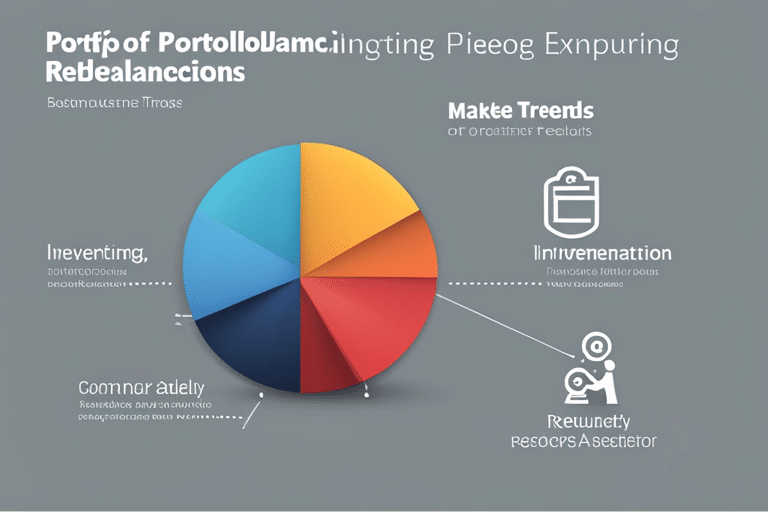Imagine you’re a skilled tightrope walker, carefully balancing your way across a narrow wire. One misstep could send everything crashing down. Just like this daring act, managing your investment portfolio requires constant attention and adjustment.
Welcome to the art of portfolio rebalancing! In this article, we will guide you through the importance of keeping your investments aligned, understanding asset allocation, evaluating risk and return, recognizing market trends, setting realistic goals, creating a strategy, implementing techniques, monitoring your progress, and reaping the benefits of rebalancing.
Get ready to master the delicate art of keeping your investments in perfect harmony!
Key Takeaways
- Regular portfolio rebalancing ensures that investments stay aligned with desired asset allocation.
- Rebalancing prevents the portfolio from becoming lopsided and unstable, reducing risk exposure.
- Taking advantage of market fluctuations through rebalancing allows for selling high and buying low, maximizing potential returns.
- Diversification is crucial for managing risk and maximizing returns, spreading investments across different asset classes, sectors, and geographic locations.
The Importance of Portfolio Rebalancing

You should understand the importance of portfolio rebalancing to ensure your investments stay aligned.
Picture this: you’re a tightrope walker, balancing on a thin wire high above the ground. Your portfolio is like that wire, and each investment is a delicate step you take. Now, imagine if you took one big step and suddenly found yourself off-balance. It’s the same with your portfolio – if you don’t rebalance regularly, it can become lopsided and unstable.
Understanding rebalancing strategies is crucial for maintaining portfolio alignment. Just like a tightrope walker adjusts their weight to keep steady, rebalancing allows you to realign your investments to match your desired asset allocation. By periodically reviewing and adjusting the proportions of different asset classes in your portfolio, you can ensure that it remains in line with your long-term goals and risk tolerance.
Think of it as tending to a garden – if left unattended, certain plants may overshadow others or grow out of control. Rebalancing helps prune back those overgrown investments and nurture the ones that need attention. This way, you create harmony within your portfolio by reducing risk exposure and maximizing potential returns.
Rebalancing also gives you an opportunity to take advantage of market fluctuations. When certain asset classes perform exceptionally well or poorly, rebalancing allows you to sell high and buy low – effectively buying more of what’s undervalued while trimming back on what’s overvalued.
Understanding Asset Allocation

So, you’ve got your portfolio balanced and aligned, but let me tell you something – diversification is the name of the game!
It’s like having a variety pack of snacks – you never know which one will be your favorite until you try them all.
And when it comes to risk management strategies, well, think of it as having an umbrella on a cloudy day – it may not prevent every drop from falling on you, but it sure helps keep you dry.
Importance of Diversification
Diversification is crucial for managing risk and maximizing returns in your investment portfolio. It’s like having a buffet of investments, where you spread out your money into different options, rather than putting all your eggs in one basket.
Here are some key diversification strategies to consider:
- Asset Allocation: Mix up your investments across different asset classes such as stocks, bonds, and real estate.
- Sector Diversification: Spread your investments across various industries like technology, healthcare, and energy.
- Geographic Diversification: Invest in companies from different countries or regions to reduce the impact of local economic events.
- Time Diversification: Invest regularly over time to average out market fluctuations.
By diversifying your investments, you can benefit from reduced risk and potentially increase your chances of higher returns.
Risk Management Strategies
When it comes to risk management strategies, it’s important to regularly assess and adjust your investment portfolio. After all, investing is like an intricate dance – you need to stay nimble and adaptable to keep up with the ever-changing market. By implementing effective risk management techniques and mitigation strategies, you can minimize potential losses and maximize potential gains.
To help you understand different approaches to managing risk, here’s a handy table that highlights three popular strategies:
| Strategy | Description |
|---|---|
| Asset allocation | Spreading your investments across various asset classes |
| Diversification | Investing in a wide range of securities within each asset class |
| Stop-loss orders | Setting predefined thresholds for selling investments |
Evaluating Risk and Return

So, you’ve been making some smart investments and watching your portfolio grow.
But now it’s time to take things to the next level and really maximize those investment returns.
In this discussion, we’re going to dive into risk assessment techniques that will help you make informed decisions and keep your investments on the right track.
Plus, we’ll explore some clever strategies for squeezing every last drop of return out of your hard-earned money.
Let’s get ready to supercharge your investment game!
Risk Assessment Techniques
Assessing risk is crucial when managing your investment portfolio. It helps identify potential vulnerabilities. To effectively evaluate risk, you need to employ various techniques that will enable you to make informed decisions.
Here are some risk assessment techniques to consider:
- Scenario analysis: Imagine different scenarios and assess how they would impact your investments.
- Stress testing: Simulate extreme market conditions to gauge the resilience of your portfolio.
- Historical data analysis: Study past market trends and patterns to predict future performance.
- Sensitivity analysis: Determine how changes in specific variables can affect your investments.
By utilizing these risk assessment techniques, you will be better equipped to optimize your portfolio and align it with your investment goals.
Now that you have assessed the risks, let’s dive into the exciting world of maximizing investment returns.
Maximizing Investment Returns
To maximize your investment returns, it’s important to implement effective strategies and stay informed about market trends. One powerful strategy for achieving this is by implementing rebalancing techniques in your portfolio management. By periodically reviewing and adjusting the allocation of your investments, you can ensure that your portfolio remains aligned with your goals and risk tolerance.
📊 Here’s a fun table to help you visualize the benefits of maximizing investment returns through rebalancing:
| Rebalancing Techniques | Benefits |
|---|---|
| Regular Portfolio Check-ups | Maintains desired asset allocation |
| Selling High, Buying Low | Takes advantage of market fluctuations |
| Diversification | Reduces overall risk |
Recognizing Market Trends

Recognizing market trends is crucial in maintaining a well-balanced investment portfolio. As an investor, you want to stay ahead of the game and make informed decisions that will maximize your returns. But how can you accurately forecast the market and develop effective investment strategies?
Here are a few tips to help you master the art of recognizing market trends:
-
Embrace the Crystal Ball: Okay, maybe not a real crystal ball, but staying on top of current events, economic indicators, and financial news can give you valuable insights into market trends. Keep an eye out for emerging industries, technological advancements, and global events that may impact different sectors.
-
Follow the Smart Money: Pay attention to what successful investors are doing. Monitor their moves, analyze their strategies, and learn from their successes (and failures). Their expertise can provide valuable guidance when it comes to identifying lucrative opportunities.
-
Be Open to Change: Markets are dynamic and constantly evolving. Don’t get stuck in old habits or rigid investment strategies. Stay adaptable and open-minded to new ideas and approaches. Flexibility is key when it comes to recognizing shifting market trends.
-
Leverage Technology: Take advantage of advanced tools and technology available today for market analysis. Automated trading systems, data analytics platforms, and artificial intelligence algorithms can provide valuable insights into market patterns and help you make more informed decisions.
Setting Realistic Investment Goals

As an investor, it’s important to establish realistic investment goals that align with your financial situation and risk tolerance. You want to set yourself up for success, not disappointment! So, let’s dive into some realistic investment strategies and long-term financial planning that will help you achieve your goals.
One key aspect of setting realistic investment goals is understanding the importance of diversification. By spreading your investments across different asset classes, you can reduce the overall risk in your portfolio. Take a look at this table below:
| Asset Class | Expected Return |
|---|---|
| Stocks | 8% |
| Bonds | 4% |
| Real Estate | 6% |
| Commodities | 5% |
By having a mix of stocks, bonds, real estate, and commodities in your portfolio, you can aim for a more balanced return and minimize the impact of any one asset class underperforming.
Another strategy to consider is dollar-cost averaging. This means investing a fixed amount regularly over time rather than trying to time the market. This approach takes advantage of market fluctuations by buying more shares when prices are low and fewer shares when prices are high.
By incorporating these realistic investment strategies into your long-term financial planning, you can increase the likelihood of achieving your desired outcomes. But remember, investing is not just about making money—it’s also about managing risk effectively.
Now that we’ve covered setting realistic investment goals based on sound strategies and long-term planning techniques, let’s move on to determining your risk tolerance and how it impacts your investment decisions.
Determining Your Risk Tolerance

Alright, you’ve set your investment goals and now it’s time to determine your risk tolerance. This step is crucial in ensuring that your portfolio aligns with your comfort level and financial objectives. So let’s dive into evaluating your risk appetite!
-
Assessing Risk Appetite: Take a moment to reflect on how much risk you are willing to take when it comes to investing. Are you more of a cautious investor who prefers stability, or are you willing to take on higher risks for potentially greater returns? Knowing where you stand will help guide your decision-making process.
-
Risk Tolerance Evaluation: Now that you have an idea of your risk appetite, it’s time to evaluate your risk tolerance. Consider factors such as your age, income, financial obligations, and future plans. These elements will influence how much volatility or unpredictability you can handle in the market.
-
Time Horizon: Think about how long you plan on leaving your investments untouched. If you’re saving up for retirement that’s still decades away, then you might be able to stomach short-term fluctuations in the market. However, if you’re nearing retirement or have upcoming financial commitments, a more conservative approach may be suitable.
-
Emotional Resilience: Lastly, gauge how well you handle stress and emotional rollercoasters. Investing can be filled with ups and downs – moments of excitement and periods of worry. Understanding how emotionally resilient you are can help determine the level of risk that won’t keep you awake at night.
Now that we’ve determined your risk tolerance and appetite for investing adventures, let’s move on to assessing your current portfolio…
Transitioning smoothly into the next section allows us to explore whether our existing investments are aligned with our newly discovered risk tolerance!
Assessing Your Current Portfolio

So you’ve got your portfolio set up, but how do you know if it’s performing as well as it could be? That’s where portfolio performance evaluation comes in. By assessing the returns and risks of your investments, you can determine if adjustments need to be made.
Speaking of adjustments, identifying asset allocation gaps is another important step in optimizing your portfolio. It’s like finding those missing puzzle pieces that will make everything fit together perfectly.
And finally, when it comes to rebalancing frequency considerations, think of it as maintaining the equilibrium of your financial universe. Too much or too little rebalancing can throw off the delicate balance of your investments, so finding the right frequency is key.
Let’s dive into these topics and get your portfolio on track!
Portfolio Performance Evaluation
Evaluate your portfolio’s performance regularly to ensure it aligns with your investment goals. Don’t let your investments go on autopilot; give them the attention they deserve! Here are a few techniques to help you assess how well your portfolio is doing:
-
Return on Investment (ROI): Calculate the overall return you’ve earned from your investments. Is it meeting or exceeding your expectations?
-
Volatility Analysis: Assess the level of risk in your portfolio by analyzing its ups and downs. Are you comfortable with the fluctuations?
-
Benchmark Comparison: Compare your portfolio’s performance against relevant market benchmarks. How does it measure up?
-
Diversification Check: Evaluate whether you have a balanced mix of assets across different sectors and types. Are you properly diversified?
By regularly evaluating these aspects, you can stay on top of any potential issues and make necessary adjustments to keep your portfolio aligned with your goals.
Now, let’s dive into identifying those asset allocation gaps!
Identifying Asset Allocation Gaps
To identify any gaps in your asset allocation, take a close look at the distribution of your investments across different sectors and types. Think of it as conducting a treasure hunt for hidden opportunities!
Imagine yourself as a curious explorer venturing into the world of asset allocation analysis. Armed with risk assessment techniques, you delve into the depths of your portfolio to uncover any imbalances or overexposures lurking within.
As you navigate through various sectors and investment types, you begin to piece together the puzzle of your asset allocation strategy. You may stumble upon an overconcentration in one sector, while another area remains underrepresented. Fear not!
With this newfound knowledge, you can now embark on the exciting journey of rebalancing your portfolio and aligning your investments to ensure optimal performance and mitigate risks. So grab that magnifying glass and get ready to discover the hidden gems within your asset allocation!
Rebalancing Frequency Considerations
Consider how often you should rebalance your investment portfolio to ensure it remains aligned with your financial goals and risk tolerance. Rebalancing timing is crucial in maintaining a well-diversified and profitable portfolio. Here are some considerations to help you determine the optimal thresholds for rebalancing:
-
Market Conditions: Keep an eye on market trends and volatility, as they can impact the performance of your investments.
-
Asset Allocation: Monitor the percentage of each asset class in your portfolio to avoid overexposure or underutilization.
-
Time Horizon: Adjust your rebalancing frequency based on how long you plan to hold your investments.
-
Risk Appetite: Assess any changes in your risk tolerance and adjust accordingly.
By considering these factors, you can find the sweet spot for rebalancing that keeps your investments on track.
Now let’s explore how to identify overweight and underweight assets in your portfolio.
Identifying Overweight and Underweight Assets

It’s important to identify assets that are overweight or underweight in order to effectively rebalance your portfolio. Think of it like maintaining a well-balanced diet – too much of one thing can throw off the whole system. But fear not, my friend! Identifying these overweight and underweight assets is not as daunting as it sounds.
Let’s start with the challenges posed by overweight assets. When an asset becomes overweight, it means you have invested more in it than originally intended. This can happen when the value of the asset increases over time or when you neglect to rebalance regularly. The challenge here lies in staying true to your original investment strategy while resisting the temptation to hold onto an asset that has performed well.
Now, let’s talk about the opportunities presented by underweight assets. An underweight asset is one that you have invested less in compared to your desired allocation. This could be due to a decline in its value or simply because you haven’t been actively adding more funds to it. The beauty of identifying underweight assets is that they open up opportunities for growth and diversification.
Creating a Rebalancing Strategy

Creating a rebalancing strategy involves assessing the current asset allocation and making adjustments to bring it back in line with desired targets. It’s like being the conductor of an orchestra, ensuring that each instrument is playing its part harmoniously. So, let’s dive into the world of rebalancing and discover how you can create a strategy that will keep your investments aligned.
Here are four key elements to consider when creating your rebalancing strategy:
-
Rebalancing frequency: Decide how often you want to rebalance your portfolio. Some people prefer quarterly check-ins while others opt for annual assessments. It all depends on your comfort level and how closely you want to monitor your investments.
-
Rebalancing thresholds: Set specific thresholds for when you’ll make adjustments to your portfolio. For example, if one asset class exceeds its target allocation by 5%, it may be time to rebalance. This ensures that any deviations from your desired targets are addressed promptly.
-
Consider tax implications: When rebalancing, take into account any potential tax consequences. Selling off assets could trigger capital gains taxes, so it’s essential to weigh the benefits against the costs.
-
Stay disciplined: Stick to your predetermined plan and avoid making impulsive decisions based on short-term market movements. Remember, rebalancing is about maintaining long-term alignment rather than chasing short-term gains.
By carefully considering these elements, you can create a robust and effective rebalancing strategy that suits your investment goals and risk tolerance.
Now that we’ve covered the basics of creating a rebalancing strategy, let’s explore how you can implement these techniques effectively in order to keep your portfolio aligned with optimal performance.
Implementing Rebalancing Techniques

To effectively implement rebalancing techniques, you’ll need to establish clear criteria for when adjustments should be made to your asset allocation. Think of it as a dance routine – you want to make sure all the moves are in sync and nobody is stepping on anyone’s toes. In the world of investing, this means keeping your portfolio aligned and balanced.
Now, let’s talk about rebalancing frequency. How often should you shake things up? Well, it depends on your goals and risk tolerance. If you’re someone who likes stability and can tolerate a little bit of fluctuation, then rebalancing once or twice a year might be enough for you. On the other hand, if you’re more adventurous and don’t mind a little excitement in your portfolio, then quarterly or even monthly rebalancing might be right up your alley.
But how do you know when it’s time to hit the dance floor? That’s where rebalancing thresholds come into play. These are predetermined percentages that act as signals for when adjustments need to be made. For example, let’s say your target allocation for stocks is 60%, but due to market fluctuations, it has now increased to 65%. This would trigger a signal for you to sell some stocks and buy other assets like bonds or cash in order to bring your portfolio back in line with your desired allocation.
Monitoring and Adjusting Your Portfolio

Ah, now that you’ve implemented those rebalancing techniques, it’s time to sit back and relax, right? Not quite! Monitoring and adjusting your portfolio is an ongoing process that requires your attention. So let’s dive in and see how you can keep your investments aligned.
To successfully monitor the progress of your portfolio, consider these strategies:
-
Regular check-ins: Just like keeping tabs on a plant or pet, you need to regularly assess how your investments are doing. Set aside some time each month or quarter to review your portfolio’s performance.
-
Track key metrics: Keep an eye on important indicators like asset allocation, diversification, and risk levels. By monitoring these metrics, you can identify any imbalances that may have occurred over time.
-
Stay informed: Stay up-to-date with market trends and news that may impact the performance of your investments. This will help you make more informed decisions when it comes to adjusting your strategies.
-
Rebalance when necessary: If you notice any significant deviations from your target allocation or risk tolerance, it may be time to rebalance again. Adjusting your strategies ensures that you maintain alignment with your investment goals.
Reaping the Benefits of Portfolio Rebalancing

Now that you’ve made adjustments to your portfolio, it’s time to reap the benefits of rebalancing. Picture this: you’re a master chef, carefully crafting a delicious dish. Just like adding the perfect pinch of salt or a dash of spice, rebalancing your investments is essential for achieving that savory balance in your portfolio.
So, how can you make sure you’re reaping all the benefits? Let’s dive into some rebalancing strategies and tracking performance.
First off, consider setting specific bands or thresholds for each asset class in your portfolio. This way, when one asset class deviates too much from its target allocation, you’ll know it’s time to bring it back into line. Think of it as keeping all the ingredients in harmony – too much of one thing can throw off the flavor!
Next, don’t be afraid to trim those winners and add to the underperformers. It may seem counterintuitive at first, but selling some of your top performers and reallocating funds to areas with potential for growth can help maintain that optimal balance over time.
Tracking performance is key here. Just like tasting your dish throughout the cooking process, regularly reviewing and analyzing how each investment is performing will help ensure you stay on track towards achieving your financial goals.
Remember, rebalancing isn’t a one-time deal. It’s an ongoing process that requires attention and finesse. So keep refining those flavors – er, investments – and enjoy the steady growth that comes from a well-balanced portfolio.
Bon appétit!
Frequently Asked Questions
How Often Should I Rebalance My Portfolio?
You should rebalance your portfolio based on the frequency and timing that suits your investment goals. Find the balance between staying aligned and not overthinking it. Trust your instincts and enjoy the art of rebalancing!
What Are the Potential Drawbacks or Risks of Portfolio Rebalancing?
When it comes to portfolio rebalancing, potential drawbacks and risks are worth considering. It’s like walking a tightrope – one wrong move could throw your investments off balance. Stay vigilant and tread carefully!
Should I Rebalance My Portfolio if I Am Satisfied With Its Current Performance?
Should you rebalance your portfolio if you’re pleased with its performance? Absolutely! Rebalancing regularly reduces risk and maintains alignment. Remember, frequency and strategies of rebalancing are key to mastering the art of portfolio management.
Can I Use Automated Tools or Software to Help With Portfolio Rebalancing?
Sure, you can totally use automated tools or robo advisors to help with portfolio rebalancing! They make it super easy and convenient to keep your investments aligned without all the hassle.
Are There Any Tax Implications or Considerations When Rebalancing My Portfolio?
When rebalancing your portfolio, it’s important to consider any tax implications. You might be subject to capital gains tax if you sell investments that have appreciated in value. Be mindful of the impact on your taxes!
Conclusion
Congratulations! You’ve now unlocked the secret to mastering the art of portfolio rebalancing. Just like a skilled tightrope walker who gracefully adjusts their balance to stay on track, you too can keep your investments aligned for success.
Remember, in the ever-changing world of finance, staying flexible is key. So, imagine yourself as a nimble acrobat, effortlessly adapting to market trends and setting realistic investment goals.
By implementing a well-crafted rebalancing strategy and regularly monitoring your portfolio’s performance, you’ll be able to reap the benefits of this invaluable technique.
Happy investing!

